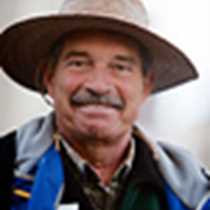San Jose Channel and Punta San Marcial on the Mainland of Baja California Sur, Mexico
The sunrise today was one of the most marvelous we have seen in a long time. All the tonalities of pink and orange on a grayish cloud illuminated the sky as we sailed through the waters between Isla San Jose and the mainland of the peninsula of Baja California.
Blue whales! Those largest of animals ever to live on our planet broke the waters of the Gulf of California, and blew enormous quantities of air up into the sky, and pulled in just the same amount! About seventeen of these behemoths were to be seen during our morning of sea mammal observations, two of them were mother/calf pairs. Definitely feeding in the cool waters of the Gulf, these animals cruised back and forth, following the distribution of the enormous masses of plankton upon which they feed.
At midday, immediately after lunch, we were already at our afternoon destination: Punta San Marcial, on the Baja Peninsula. Here we promptly set out to land on the sandy beach and, in various groups, walked into the land along lovely washes or arroyos, where a big number of interesting plants were seen, among which were the trees of ironwood, Palo Blanco, Palo Verde and others. Among the bushes were the skunky-smelling Ruellias with their brilliant purple flowers, the brittlebush, and the always-present cacti. The giant of them all was the cardon, followed by the organpipe cactus, old-man cactus and the smaller sour pitahaya and barrel cactus.
Geologically the sights were awesome: towering walls of crushed and pressed volcanic ashes, also called volcanic tuff, in huge mesas and cylinders, all of different hues of brown, reds and light gray. The birds were also lovely, as we saw many sea birds such as magnificent frigatebirds, pelicans, brown boobies and even hawks and a peregrine falcon!
Cacti have their own way of protecting themselves from water loss, which would drastically jeopardize their presence in the desert. Among other strategies, some physiological and others anatomical, are the thick cuticle, waxy substances to waterproof it even more, spines, and especially the presence of different chemicals to protect themselves from the always-present herbivores. These chemicals consist mainly of oxalic acid (of which the old-man cactus here photographed has enormous amounts) and betalains, both toxic. As the cactus gets older, the heads get covered with brown hair, and as years go by, these spines become white!
The sunrise today was one of the most marvelous we have seen in a long time. All the tonalities of pink and orange on a grayish cloud illuminated the sky as we sailed through the waters between Isla San Jose and the mainland of the peninsula of Baja California.
Blue whales! Those largest of animals ever to live on our planet broke the waters of the Gulf of California, and blew enormous quantities of air up into the sky, and pulled in just the same amount! About seventeen of these behemoths were to be seen during our morning of sea mammal observations, two of them were mother/calf pairs. Definitely feeding in the cool waters of the Gulf, these animals cruised back and forth, following the distribution of the enormous masses of plankton upon which they feed.
At midday, immediately after lunch, we were already at our afternoon destination: Punta San Marcial, on the Baja Peninsula. Here we promptly set out to land on the sandy beach and, in various groups, walked into the land along lovely washes or arroyos, where a big number of interesting plants were seen, among which were the trees of ironwood, Palo Blanco, Palo Verde and others. Among the bushes were the skunky-smelling Ruellias with their brilliant purple flowers, the brittlebush, and the always-present cacti. The giant of them all was the cardon, followed by the organpipe cactus, old-man cactus and the smaller sour pitahaya and barrel cactus.
Geologically the sights were awesome: towering walls of crushed and pressed volcanic ashes, also called volcanic tuff, in huge mesas and cylinders, all of different hues of brown, reds and light gray. The birds were also lovely, as we saw many sea birds such as magnificent frigatebirds, pelicans, brown boobies and even hawks and a peregrine falcon!
Cacti have their own way of protecting themselves from water loss, which would drastically jeopardize their presence in the desert. Among other strategies, some physiological and others anatomical, are the thick cuticle, waxy substances to waterproof it even more, spines, and especially the presence of different chemicals to protect themselves from the always-present herbivores. These chemicals consist mainly of oxalic acid (of which the old-man cactus here photographed has enormous amounts) and betalains, both toxic. As the cactus gets older, the heads get covered with brown hair, and as years go by, these spines become white!




